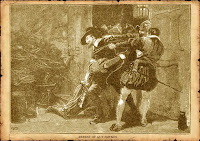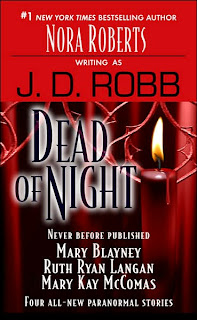The prize you won, Mary Blayney’s signed copy of Dead of Night, is too special to go uncollected, so please contact us at riskies@yahoo.com before midnight Monday, November 11.
If we do not hear from you by then, we will select a new winner.
The prize you won, Mary Blayney’s signed copy of Dead of Night, is too special to go uncollected, so please contact us at riskies@yahoo.com before midnight Monday, November 11.
If we do not hear from you by then, we will select a new winner.
 The Plague (aka a cold) is…plaguing…the Riskies. Janet is the latest to succumb, although we are unsure how the germ was transmitted from Elena in upstate New York to Janet in the Maryland suburbs of Washington, DC. Janet is sufficiently under the weather that her pale, trembling fingers tapped out an urgent message for somebody, anybody, to take over the blog for today. Personally, I think her secret stash of Gerard Butler DVDs finally arrived from Netflix and she’s holed up in front of the telly.
The Plague (aka a cold) is…plaguing…the Riskies. Janet is the latest to succumb, although we are unsure how the germ was transmitted from Elena in upstate New York to Janet in the Maryland suburbs of Washington, DC. Janet is sufficiently under the weather that her pale, trembling fingers tapped out an urgent message for somebody, anybody, to take over the blog for today. Personally, I think her secret stash of Gerard Butler DVDs finally arrived from Netflix and she’s holed up in front of the telly.
On Monday I missed the grand opportunity to blog about Guy Fawkes Day. Life sometimes gives us second chances, you know…
Who was Guy Fawkes and why do the English make a holiday of him?
He was one of the zealot Catholic conspirators in 1605 who plotted to blow up Parliament and all the lords attending and King James I, effectively putting an end to the existing government. November 5 was the opening day of Parliament and all the important governmental men would be in attendance. Someone snitched, however, and the cellar beneath Parliament was searched. Guy Fawkes, the fellow who was supposed to light the fuse to blow up 36 kegs of gunpowder, was discovered, arrested (as were all the other conspirators, eventually), tortured, hanged, drawn and quartered. And the English have celebrated that event ever since……
 The BBC website has some neat stuff about Guy Fawkes and his Day, including an interactive game where one must find the gunpowder in the cellar and answer questions about GF Day along the way. If you don’t want the powder to explode, I suggest you first read the history of the Gunpowder Plot–voice of experience, here. There’s also a very interesting piece about what would have happened if the conspirators had succeeded.
The BBC website has some neat stuff about Guy Fawkes and his Day, including an interactive game where one must find the gunpowder in the cellar and answer questions about GF Day along the way. If you don’t want the powder to explode, I suggest you first read the history of the Gunpowder Plot–voice of experience, here. There’s also a very interesting piece about what would have happened if the conspirators had succeeded.
And that brings me to what the Plague has to do with Guy Fawkes. Well, it seems that Parliament was originally supposed to open October 5, but was postponed a month to make certain the Plague was gone from London. By delaying a month, more conspirators became involved in the plot, increasing the chance that somebody would snitch. What’s more, the gunpowder, sitting around all that time, separated into it various compounds and would have merely fizzled had Guy lit the fuse.
Now if he’d lit that fuse on Oct 5….
Read about how history would have been changed for want of a few plague germs.
Do you ever wonder what would have happened if some pivotal event in history had been altered?
Cheers!
Diane

Lindsey!
You have won a copy of Dead of Night, signed by Mary Blayney, JD Robb/Nora Roberts, Mary Kay McComas and Ruth Ryan Langan!
Please send your contact details to riskies@yahoo.com
 I’m doing research for a new book. I won’t say too much it yet, but part of my research has been about the last frost fair held on the Thames for a few days in February, 1814.
I’m doing research for a new book. I won’t say too much it yet, but part of my research has been about the last frost fair held on the Thames for a few days in February, 1814.
From about the mid 14th century to the early 19th century (the little ice age), the Thames sometimes froze solid in the winter and fairs were held on its ice. The climate was not the only reason the river turned to ice. The Thames was shallower then and the old London Bridge was built in a manner that slowed the flow of water and fostered freezing.
The first recorded frost fair was held in 1608, but the one I wanted to know about was the frost fair of 1814, The Last Frost Fair.
Joy Freeman wrote one of my favorite old Regencies titled The Last Frost Fair, which is where I first heard of the event. It seemed perfect to use in my new story and I knew just where to look for more information–The Annual Register of 1814
I have all the Annual Registers from 1810 to 1820. The Annual Registers are a little like almanacs with all the parliamentary issues, births, deaths, marriages of important people, poetry, and the most interesting news stories from the year. The Annual Register for 1814 is on google books so you can read it for yourself. The account of the fair begins on page 11 of the Chronicles, beginning on February 1 and ending February 7.
Another book with a good description of the Frost Fair is John Ashton’s Social England under the Regency, also on googlebooks.
Ashton describes the frolickers playing skittles, drinking in tents “with females,” dancing reels, more sedate coffee-drinking, and gaming booths. Souvenir cards were printed on printing presses set up on the ice. The Annual Register said the carousing went on until the ice began to break up and then people went scrambling to safety. There was some loss of life and there never again was a freezing of the river sufficient to hold a frost fair.
Have you read any books that show the Last Frost Fair?
Did you read Joy Freeman’s book and what did you think of it?
Are you curious as to what my new book is about? (cuz I’m still not telling)
Come visit my website. I have a new contest this month, continuing my countdown to The Vanishing Viscountess in January.

 Everyone, please welcome my good friend and wonderful Regency author, Mary Blayney, who joins us today to talk about her novella Amy and The Earl’s Amazing Adventure in the anthology Dead of Night with coauthors JD Robb/Nora Roberts, Mary Kay McComas, and Ruth Ryan Langan.
Everyone, please welcome my good friend and wonderful Regency author, Mary Blayney, who joins us today to talk about her novella Amy and The Earl’s Amazing Adventure in the anthology Dead of Night with coauthors JD Robb/Nora Roberts, Mary Kay McComas, and Ruth Ryan Langan.
“…this all-new four-novella anthology definitely doesn’t suffer from standout single syndrome—this one’s all killer, no filler.” Publisher’s Weekly of Dead of Night
Mary is giving away one copy of Dead of Night, signed by ALL the authors. Just make a comment on this blog. We’ll announce the winner on Monday.
Hi, Mary!
What’s a nice Regency writer like you doing in an anthology with J.D. Robb?
How could I say no to an anthology with Nora Roberts (w/a JD Robb)? Especially when I was told that I could write anything I wanted as long as it had a paranormal element and would fit under the umbrella title. Admittedly my first novella “Poppy’s Coin” in Bump in the Night was not bumpy at all but I’m a fast learner and I took care of that in “Amy and the Earl.”
Tell us about Dead of Night, especially “Amy and the Earl’s Amazing Adventure.”
The anthology includes time travel, futuristic police procedural and a parallel world story. JD Robb is working with the fabulous Eve Dallas and her husband Roarke and a very nasty man claiming to be a vampire. Ruth’s Langan’s story is a time travel. Her contemporary heroine, Laurel, stumbles way back in time to meet the very alpha Conal MacLennan. Mary Kay McComas story is more parallel world than time travel. Bonnie rides a magic carpet to an alternate past, a chance to see what life would have been like with just a few changes.
In “Amy and the Earl’s Amazing Adventure,” Amy and Simon meet, not entirely by accident, and realize that they both are curious about the origins of a coin minted in 1810. The coin is the key element in my first novella “Poppy’s Coin” and Amy appeared in that story as the nameless tourist who hears how the coin changed the lives of my Regency lovers. The nameless girl was a sweetheart and I wanted to know more about her. Then Simon appeared, driven by a need to know how a coin minted in 1810 could be in a family portrait painted in 1805. When someone offers them the chance to time travel together they agree. The story spins out from there.
Is there a connection between the novellas?
No. I call it a “romance sampler” with something in it for every fan. It is a way to try a different genre without a big commitment of time or money.
As you said, Poppy’s Coin appears again in “Amy and the Earl’s Amazing Adventure.” How did you think of Poppy’s Coin?
My friend and talented writer, Lavinia Klein, gave me a coin known as “TheAdmiral Gardiner Shipwreck Coin,” one of thousands discovered when the ship, Admiral Gardiner, was recovered in 1985 off the Goodwin Sands beyond the Straits of Dover. The story of the ship and its cargo is fact and I included it in “Amy and the Earl,” then added my own paranormal twist. Is the coin magic? Not that I know of, but my writing career has changed dramatically since it came into my life. Which came first the chicken or the egg?

 You have written some lovely Regencies, His Last Lover, The Pleasure of His Company and The Captain’s Mermaid. How was it to write contemporary characters, even if they did travel back to 1805?
You have written some lovely Regencies, His Last Lover, The Pleasure of His Company and The Captain’s Mermaid. How was it to write contemporary characters, even if they did travel back to 1805?
It was a cross between great fun and real work. The chance to have characters speak in a contemporary voice was a great change of pace, especially when they were back in the Regency and using modern language leads to some confusion. On the other hand I am so much more familiar with the Regency world that writing characters immersed in the 21st century actually took some research. How’s that for a flip-flop?
What was risky about “Amy and the Earl’s Amazing Adventure?”
Without a doubt the riskiest thing was writing a story that was plot driven and not character driven. This is the first time I have ever tried it. The readers will have to tell me if it works.
I know you love the Regency. How come?
It is that moment in history when the world is on the cusp of change, when man is about to move from an agrarian society to an industrial one. When the individual begins to become more important than the group. I think that last transition is why marrying for love became acceptable. That is, what the individual wanted gradually became more important than what was good for the family. The tension of those two elements and the Napoleonic War make it an era filled with conflict on a level that ranges from international to interpersonal. And I love the clothes and the houses.
Did you come upon any interesting research for this novella?
You mean besides learning about 21st century men and woman? Yes, I researched the artists Guardi and Canaletto. In the process learning an interesting tidbit about Rembrandt that I used in the story. I also spent a lot of time with Google Earth and my Regency maps of London trying to find a locale that could be both a pub and a Regency town house. It was a great way to waste time, I mean research. Sure enough I found the perfect spot in a part of London I have actually visited.
At the end of January 2008, my first single title comes out. Traitor’s Kiss is the first of three books for Bantam. It is a family series and I am currently working on the second. Traitor’s Kiss features the youngest son of the five children of the Duke of Meryon. Lord Gabriel Pennistan went to Spain in 1811 as a man of science and wound up in a French prison, even though it is the English who consider him a spy and a murderer. He is rescued by the mysterious Charlotte Parnell. Each discovers the truth about the other as they escape from France. There is also a third anthology in the works and, yes, in this one the magic coin makes an appearance once again though it is essentially a ghost story. The umbrella title is Suite 606 and the title of my novella is (currently) “Love Endures”
Thanks so much for inviting me to join the Riskies for the day. Hope to hear from lots of bloggers and am happy to offer as a prize a copy of Dead of Night autographed by all four of the authors.
